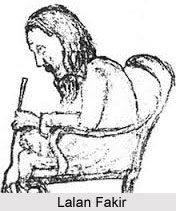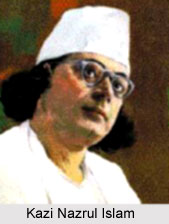 The Muslim poets of Bengal cannot be segregated from their Hindu counterparts. They introduced several Persian and Arabic words in their vocabulary. They borrowed the themes images and ideas from Sanskrit. They even wrote on Hindu Mythology with much reverence. This is seen in the Padavali written by Nasir Mahmud, Saiyad Marttuza, Saiyad Sultan, Ali Raja, Alaol and others of the seventeenth century.
The Muslim poets of Bengal cannot be segregated from their Hindu counterparts. They introduced several Persian and Arabic words in their vocabulary. They borrowed the themes images and ideas from Sanskrit. They even wrote on Hindu Mythology with much reverence. This is seen in the Padavali written by Nasir Mahmud, Saiyad Marttuza, Saiyad Sultan, Ali Raja, Alaol and others of the seventeenth century.
During the mediaeval period Bengali literature developed considerably with the patronage of Muslim rulers especially Sultan Alauddin Hussein Shah, his son Nasrat Shah and commander-in-chief, paragal khan. Chand Kazi (15th century) and Afzal Ali (17th century) were the known poets at that time. Syed Sultan, Sheikh Paran, Haji Muhammad, Nasrullah Khan, Muhammad Khan, Syed Martuza, Sheikh Muttalib, Mir Muhammad Shafi, Abdul Hakim.
Poets of the seventeenth century include nawajis khan , Qamar Ali, Mangal, Abdul Nabi, Muhammad Fasih, Fakir Garibullah, Muhammad Yakub, Sheikh Mansur, Muhammad Uzir Ali, Sheikh Sadi and Heyat Mamud. Syed Sultan`s Nabibamsa , Muhammad Khan`s Maktul Husein and sheikh chand `s Rasulbijay are known as Islamic Puranas. Shah Muhammad Sagir who belonged to the fourteenth century was one of the earliest of the Bengali Muslim poets. Other poets include Jainuddin(Rasulbijay), Muzammil (Nitishastravarta, Sayatnama and Khanjancharita), Sheikh Faizullah, Daulat Uzir Bahram Khan.
Daulat Kazi and Sekh Fayzulla have made contributions to Nath literature. Saiyad Zafar has contributed to Kali literature. There was nothing Islamic in compositions of these writers. They enlarged the content of Bengali literature with the Islamic ideas they expressed and the themes they had introduced from Arabic and Persian sources.
 They had imported from abroad some tales which are like to the Arabian Nights, such as those of Hatem-tai, Leila-Majnun, and Yusuf-Zulekha. The royal court of Arakan gave patronage to several of Muslim poets especially Alaol. The tales of Hanif, Amir Hamza and Sonabhan were popular especially in east Bengal.
They had imported from abroad some tales which are like to the Arabian Nights, such as those of Hatem-tai, Leila-Majnun, and Yusuf-Zulekha. The royal court of Arakan gave patronage to several of Muslim poets especially Alaol. The tales of Hanif, Amir Hamza and Sonabhan were popular especially in east Bengal.
Alaol wrote several long poems which were based on original Persian stories: Saifulmulk, Hapta Paykar, Tohfa, Badiuj-jamal and Sikandar-nama. He displays a Sanskrit scholarship and he had immense knowledge of Hindu customs. However he gets involved in complex metaphysical ideas. He writes in Sanskritized style which makes him the initiator of the neo-classicism that was perfected by Bharatchandra Ray in the eighteenth century.
Saiyad Sultan, who was a native of Paragalpur in Chittagong district, wrote poems like Jivan-pradip, Sabe-meyaraz and Nabi-vamsa. Nabi vamsa is a poem that speaks of the synthesis that was going on between Hinduism and Islam. Some of the other writers of the seventeenth century are Daulat Kazi, the oldest Arakan poet and the author of Sati Maynamati, Sekh Chad, author of Rasul-vijay; Muhammad Khan, author of Maqtul-Husain; Sah Muhammad Sagir, author of Yusuf-Zulekha and Abdul Nabi, author of Amir Hamza. Hayal Mahmud was the most notable Muslim poet of the eighteenth century who was the author of several works including Chitta Utthan.
Kavi Nazrul Islam was a poet and a revolutionary of Bengal. He flourished in the nineteenth century. He wrote on all possible themes. He is known for his poems. He had composed around four thousand songs also known as `Nazrul geeti`.













